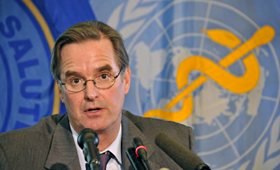
 PAHO Deputy Director Dr. Jon Andrus with updated information about the cholera outbreak in Haiti. A transcript of the press briefing can be found here.
PAHO Deputy Director Dr. Jon Andrus with updated information about the cholera outbreak in Haiti. A transcript of the press briefing can be found here.
Cholera Outbreak in Haiti
Jon Kim Andrus, MD
Deputy Director
Pan American Health Organization
9 November 2010
I want to thank all of you for participating in today's news conference. We hold these briefings to provide you an update on the ground situation in Haiti.
 It is a relief to note that the impact of Hurricane Tomas was not as immediately catastrophic as we all feared, particularly if you compare it to the hurricane that struck Haiti in 2008.
It is a relief to note that the impact of Hurricane Tomas was not as immediately catastrophic as we all feared, particularly if you compare it to the hurricane that struck Haiti in 2008.
The most heavily hit departments were the South and Grand' Anse, creating important needs for food, potable water and hygiene kits in these areas.
A number of hospitals were evacuated, along with thousands of people in vulnerable areas, but they are gradually returning to their homes or their camps.
Initial assessments indicate that Haiti's agricultural sector was the most heavily affected, with flooded fields and major losses in livestock and crops.
We have every reason to expect that the widespread flooding has increased the risk of cholera spreading. The effects of this could become apparent through an upsurge of cases over the coming days.
Before we get into the actual case counts, I'd like to take a step and put the situation in context for you.
Cholera is a complex public health emergency under any circumstances. And certainly in Haiti, the hemisphere's poorest country, the problem is even more complex.
The country's water and sanitation infrastructure was inadequate to begin with. Then, in January of this year, an earthquake struck the nation, killing 200,000 people and forcing more than 1.3 million people into tents and displacement camps, where they still live today.
To make matters worse, the flooding and mudslides from last week's hurricane pushed rivers over their banks, very likely spreading cholera even further.
So that is the context of the current situation.
To give some historical context: the cholera epidemic that began in Peru in 1991 spread to some 16 other countries throughout the hemisphere, from Argentina to Canada, with cases even reported in Montreal and New York City. In Peru alone, it produced more than 650,000 cases over six years.
At the time, Peru's population was about two-and-a-half times larger than today's Haitian population. Extrapolating from Peru's experience, one might expect upwards of 270,000 cases if Haiti's epidemic continues for several years, as did Peru's.
As of yesterday, the Ministry of Health was reporting more than 9100 hospitalized cases and some 583 deaths in some 240 communities. These include 73 cases reported in Port-au-Prince. We expect these numbers to continue to rise as more cases are detected.
As I have noted in earlier briefings, you may hear different case counts from different sources.
Reconciling these numbers is an important priority for PAHO and PAHO is supporting Haiti's Ministry of Health in this area.
Before the current outbreak, Haiti was in the process of improving its epidemiological surveillance system, that system responsible for detecting diseases and monitoring trends in diseases. This was begun after the earthquake in January. The main challenge was --and currently is-- integrating case counts from different health providers, including nongovernmental organizations like Doctors without Borders and Partners in Health, as well as bilateral partners such as Cuban health providers.
To help the Ministry better integrate these various sources, PAHO has mobilized experts in epidemiology to continue improving the surveillance system. This work also includes establishing reporting sites in all the shelter areas.
As this work progresses, there should be more consistency in the numbers. However, I want to emphasize —as I have emphasized a number of times before -- that the case numbers are not as important as the underlying trends, and our top priority is treating the sick and preventing new cases.
So what are we doing to prepare for an increase in cases that we expect? The answer is, we are doing everything we can -- to save lives.
In anticipation of the hurricane, PAHO pre-positioned cholera-related and other medical supplies in the major urban centers of the south and north, Les Cayes and Cap Haïtien; as well as Port-au-Prince and St. Marc, the epicenter of the outbreak.
From these points, NGOs and other partners are able to pick up their supplies free of charge and distribute them according to their needs.
PAHO's PROMESS warehouse has continued to distribute medicines and supplies to hospitals and organizations in four departments.
PAHO also has deployed a team of experts to Port-au-Prince to help scale-up operations at PROMESS, the central warehouse where supplies and medicines are stored, in coordination with Haiti's Department of Civil Protection.
We continue to work with Haiti's Ministry of Health, NGOs, the CDC and Canada, among other partners to get needed supplies into communities and health facilities and to prepare for the expected upsurge in new cases.
One final note: the UN Stabilization Mission in Haiti, MINUSTAH, said recently that there is no objective reason to delay elections and that they are scheduled for November 28. You may recall, they were originally scheduled for last February, but they were postponed following the Jan. 12 earthquake.)
From a health perspective, there is no reason to expect the elections to have a negative impact on the cholera epidemic. And in fact, the Ministry of Health is planning to use the occasion to disseminate prevention messages to the population. It will help prevent the spread of infection.
I will stop now and take any questions.



